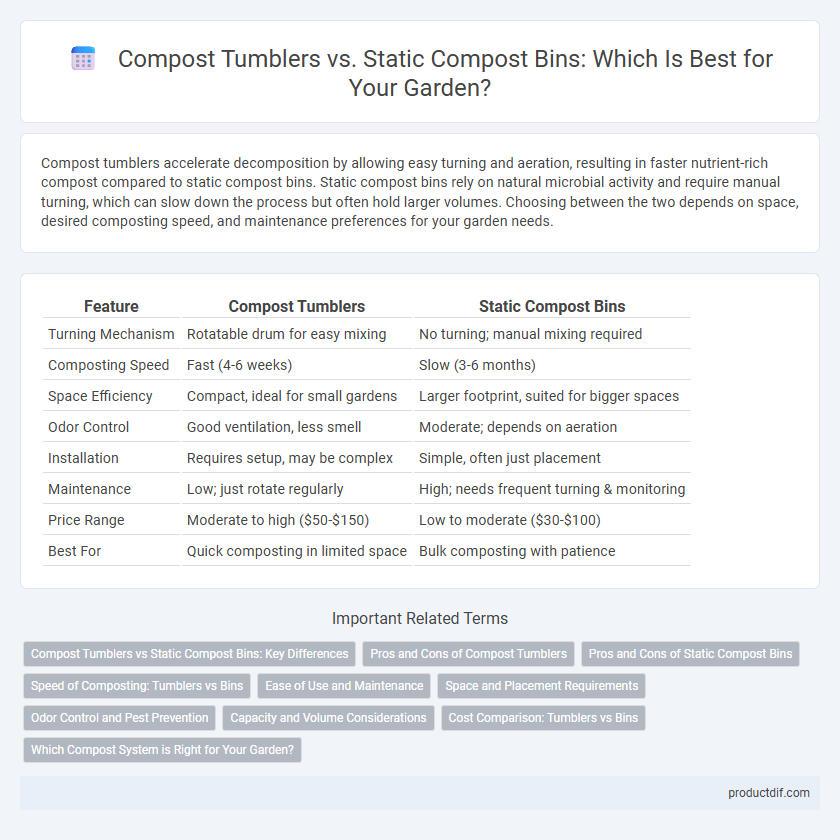Compost tumblers accelerate decomposition by allowing easy turning and aeration, resulting in faster nutrient-rich compost compared to static compost bins. Static compost bins rely on natural microbial activity and require manual turning, which can slow down the process but often hold larger volumes. Choosing between the two depends on space, desired composting speed, and maintenance preferences for your garden needs.
Table of Comparison
| Feature | Compost Tumblers | Static Compost Bins |
|---|---|---|
| Turning Mechanism | Rotatable drum for easy mixing | No turning; manual mixing required |
| Composting Speed | Fast (4-6 weeks) | Slow (3-6 months) |
| Space Efficiency | Compact, ideal for small gardens | Larger footprint, suited for bigger spaces |
| Odor Control | Good ventilation, less smell | Moderate; depends on aeration |
| Installation | Requires setup, may be complex | Simple, often just placement |
| Maintenance | Low; just rotate regularly | High; needs frequent turning & monitoring |
| Price Range | Moderate to high ($50-$150) | Low to moderate ($30-$100) |
| Best For | Quick composting in limited space | Bulk composting with patience |
Compost Tumblers vs Static Compost Bins: Key Differences
Compost tumblers offer faster decomposition by allowing easy aeration through rotation, while static compost bins rely on manual turning and natural airflow for breakdown. Tumblers typically provide a contained, pest-resistant environment that speeds up the composting process, whereas static bins are often larger and better suited for yard waste and bulk composting. Choosing between compost tumblers and static compost bins depends on available space, composting speed preference, and maintenance effort.
Pros and Cons of Compost Tumblers
Compost tumblers offer faster decomposition by providing regular aeration through easy rotation, which accelerates the breakdown of organic materials. They require less physical effort to turn compared to static compost bins but often come with higher initial costs and limited capacity, making large-scale composting challenging. Tumblers also help reduce pests and odors due to enclosed design, though they may dry out more quickly, necessitating frequent monitoring of moisture levels.
Pros and Cons of Static Compost Bins
Static compost bins offer a low-maintenance option for garden waste decomposition, requiring less frequent turning compared to compost tumblers. They provide a larger capacity suitable for bulky garden debris but may slow the composting process due to limited aeration and longer decomposition times. Static bins are generally more affordable and durable, making them ideal for gardeners seeking simplicity over speed in organic waste recycling.
Speed of Composting: Tumblers vs Bins
Compost tumblers accelerate decomposition by allowing frequent, easy turning of organic material, increasing oxygen flow and promoting faster microbial activity compared to static compost bins. Static bins rely on natural aeration and require manual mixing, which often slows down the composting process. Consequently, tumblers can produce finished compost in as little as 2-4 weeks, whereas static bins typically take 2-6 months.
Ease of Use and Maintenance
Compost tumblers offer superior ease of use with their rotating design, allowing for effortless mixing of organic materials that speeds up decomposition. Static compost bins require regular manual turning with tools such as pitchforks, making maintenance more labor-intensive and time-consuming. Both options benefit from proper aeration and moisture control, but tumblers minimize physical effort, making them ideal for gardeners seeking low-maintenance composting solutions.
Space and Placement Requirements
Compost tumblers require more space due to their rotating mechanism and are best placed in open, accessible areas for easy turning. Static compost bins have a compact footprint, making them ideal for smaller gardens or corner placements where space is limited. Choosing between the two depends on available garden space and ease of access for maintenance.
Odor Control and Pest Prevention
Compost tumblers offer superior odor control by promoting better aeration and faster decomposition, reducing the risk of unpleasant smells. Static compost bins often retain moisture and organic matter, which can attract pests such as rodents and flies if not managed carefully. Effective pest prevention in tumblers comes from the enclosed, rotating design that minimizes access points and discourages infestations.
Capacity and Volume Considerations
Compost tumblers typically offer smaller capacities ranging from 5 to 15 gallons, ideal for small to medium-sized gardens, while static compost bins can accommodate larger volumes, often exceeding 100 gallons, suitable for substantial organic waste. The limited volume of tumblers requires frequent emptying and turning to maintain optimal decomposition, whereas static bins allow for bulk composting with less frequent maintenance. Choosing between the two depends on available space, organic waste production, and desired compost turnover speed.
Cost Comparison: Tumblers vs Bins
Compost tumblers generally cost between $80 and $300, offering faster decomposition through regular aeration but requiring a higher upfront investment compared to static compost bins, which typically range from $30 to $150. Static compost bins are more affordable and low-maintenance but may take several months longer to produce finished compost due to limited aeration. Choosing between compost tumblers and static bins depends on budget constraints and the desired speed for compost production.
Which Compost System is Right for Your Garden?
Compost tumblers offer faster decomposition by allowing easy aeration and mixing, making them ideal for gardeners seeking quick nutrient-rich soil amendments. Static compost bins provide a larger capacity and require less maintenance, perfect for those with bigger gardens who prefer a hands-off approach. Choosing between a tumbler or static bin depends on garden size, composting speed desired, and time available for upkeep.
Compost Tumblers vs Static Compost Bins Infographic

 productdif.com
productdif.com